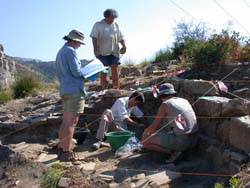
 clicca quà per testo in italiano
clicca quà per testo in italiano
The Umbro Greek Site is located on a small, steep irregular hill adjacent to the cobbled medieval or early modern road leading from the coast up to the Umbro plateau and ultimately to the hilltop town of Bova. This road may follow a route similar to a road many centuries older, dating back to classical antiquity. The hill is one of the steeply sloping outcrops of calcareous sandstone which forms the series of cliffs bounding the fertile and well-watered Umbro plateau on the east. Several other small Greek sites were located around the plateau by archaeological survey. The Umbro Greek site was excavated between 2000 and 2005.
The Umbro Greek site is a well-preserved example of the small rural 'farmhouse' sites typical of those found by archaeological surveys throughout the archaic and classical Greek world. The lower end of the northern section of the hill has been bulldozed in recent years to level the area for the installation of an electrical pylon, partially destroying the site. In spite of this damage, intact deposits and architecture remain. Two sides of a west-facing residential building were excavated on the lower part of the hill (Trenches 2 and 4). The house was constructed as a stone socle with mudbrick superstructure and a tiled roof, including a chimney tile. Traces of other similarly constructed buildings were found near the summit (Trenches 3 and 6). The overwhelming bulk of the material excavated in the 2000-05 seasons is classical in date. The house in Trenches 2 and 4 dates to between 425 and around 350 BC. It may be the case, as with similar sites in Metaponto, that earlier (archaic and/or prehistoric) occupation of the site has been virtually obliterated by the construction of the surviving classical buildings. Ceramic material in the ancient ground levels underneath the western retaining wall of the site in Trench 4, and broken tiles utilised in the wall fill of the SE-NW wall in Trench 2, support the case for earlier structures on the site. There was probably also a late Archaic occupation of the site. Evidence from the areas of Trenches 3 and 6 (on the top of the hill) suggests that use of the site extends into the 3rd century BC.
Although the lifetime of the preserved classical building was relatively short (probably no more than 50-75 years), two separate phases of occupation could be distinguished in Trench 2. The earlier phase is attested by residential evidence: pottery for eating and drinking as well as environmental evidence of food processing and cooking discovered on the floor levels; this suggests that this occupation was year-round and permanent. Following the collapse and abandonment of the house, a new earth floor was laid down directly over the large tiles of the earlier fallen roof. Internal walls were added, dividing the building into small, narrow units which possibly functioned as animal stalls. A sheep's tooth belonging to this secondary phase of occupation may support this idea.
Two small bronze coins found on the site suggest that its main political (and perhaps economic) connections were with Rhegion. Interpretation of this depends upon placing this classical farmhouse in its larger geographical context: how the Umbro Greek 'farmhouse' and similar sites functioned as part of large rural territory of Rhegion is one of our key questions.
For images of some finds from Umbro Greek site, see here.
Il sito greco di Umbro sorge su una piccola e scoscesa collina adiacente la strada lastricata di epoca medievale o rinascimentale che dalla costa conduce al pianoro di Umbro, e infine alla cittadina arroccata di Bova. E' possibile che questa strada ricalchi un itinerario più antico di molti secoli, forse databile all'antichità classica. La collina dove sorge il sito costituisce uno degli affioramenti di arenaria calcarea che vanno a formare la serie di rupi che circondano il fertile e irriguo pianoro di Umbro sul lato orientale. Numerosi altri siti greci, presumibilmente di piccole dimensioni, sono stati identificati grazie alle ricognizioni archeologiche. Il sito di Umbro è stato scavato tra il 2000 e il 2005.
Il sito greco di Umbro è un esempio ben conservato delle piccole 'fattorie' rurali che sono state identificate in gran numero grazie alle indagini archeologiche compiute nei territori occupati dai greci in epoca arcaica e classica. L'estremità inferiore della sezione settentrionale della collina è stata asportata in anni recenti per l'installazione di un pilone dell'elettricità, distruggendo in parte il sito. Nonostante il danno arrecato dai mezzi meccanici, rimangono in situ depositi e resti architettonici ancora intatti. Due lati di un edificio residenziale affacciato in direzione ovest sono stati scavati nella parte inferiore della collina (Saggi 2 e 4). La casa è stata edificata con uno zoccolo murario in pietra, un alzato in mattoni crudi e un tetto di tegole, che comprendeva una tegola forata utilizzata come camino. Tracce di edifici costruiti con tecniche simili sono state individuate presso la cima del colle (Saggi 3 e 6). L'enorme quantità di materiale archeologico portato alla luce nelle campagne 2000-2005 è databile ad epoca classica, e principalmente fra 425 e 350 a.C. Si può ipotizzare, per analogia con quanto evidenziato in siti analoghi a Metaponto, che tracce di occupazione precedente (di epoca arcaica e/o preistorica) siano state quasi completamente obliterate dalla costruzione degli edifici di epoca classica. Materiale ceramico raccolto nel Saggio 4, proveniente dal piano di calpestio antico al di sotto del muro di contenimento occidentale del sito, sembra indicare la presenza di strutture più antiche nel sito. Indicazioni analoghe vengono dai frammenti di tegole riutilizzate nel riempimento del muro SE-NO rinvenuto nel Saggio 2. E' probabile che c'era anche un'occupazione del sito nel tardo Arcaico, e evidenza dalle trincee 3 e 6 (in cima della collina) suggerisce che l'uso del sito si estendeva fino al terzo secolo a.C.
Sebbene l'edificio di epoca classica sia rimasto in uso per un periodo relativamente breve (probabilmente non più di 50-75 anni), nel Saggio 2 sono state distinte due diverse fasi di occupazione. La fase più antica è di tipo residenziale: nei livelli pavimentali sono stati individuati contenitori per cibi e bevande, così come reperti botanici e zoologici che indicano preparazione e cottura del cibo. Questi materiali suggeriscono che l'occupazione dell'edificio fosse permanente e non stagionale. In seguito al crollo e all'abbandono della casa venne steso un nuovo livello pavimentale in terra subito al di sopra del crollo di tegole pertinente al tetto precedente. Muri interni vennero aggiunti a dividere l'edificio in ambienti piccoli e stretti, che potrebbero essere stati utilizzati come ricoveri per animali. Un dente di ovino pertinente a questa seconda fase di occupazione sembra supportare questa interpretazione.
Due piccole monete di bronzo rinvenute nel sito suggeriscono che Umbro gravitasse nell'ambito politico e forse economico della colonia di Rhegion. Tale interpretazione dipende dalla più vasta lettura del contesto geografico di cui questa fattoria greca era parte. Infatti, una delle questioni chiave di questa ricerca è proprio se Umbro ed altre fattorie greche analoghe fossero parte integrante del territorio rurale di Rhegion.
Clicca qui per vedere immagini dei reperti dal sito.
© images and text copyright Bova Marina Archaeological Project 2011





